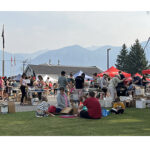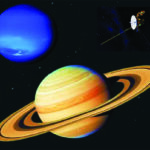Home »

The position of the planets for March
By Rick Nowell
A number of people have been asking me questions about all the bright planets visible and what our telescopes can do.
So I’ll answer them here, with starmaps and pictures taken through our college telescopes. Photos are not enhanced, so you can see what we get, although they have been reduced in size.

For you early morning people up at 6:30 a.m., three bright planets are nicely spread out in an even line across the sky. The starmap (right) shows them, this is for March 10 at 6:30 a.m., facing south. It shows Mercury (MER) and Venus (VEN) rising in the east, followed by Saturn (SAT), then Mars to the southwest. Pluto and Neptune are even present, but not visible unless you have a large telescope! The starmap shows the horizon as a green line, with directions S for south, SE southeast, etc. The dotted red line is the ecliptic – the plane that the planets appear to move along. The blue band is the Milky Way.
Since Mercury is so close to the Sun, there are only six times in the year when Mercury is far enough from the Sun above the horizon to be visible, at its “angle of maximum elongation.” Three of these times are in the dawn, and three at dusk. Mercury was highest in the Eastern morning sky on March 14 for a few days before and after. It appeared as a half crescent, like Venus, but about 50% illuminated.
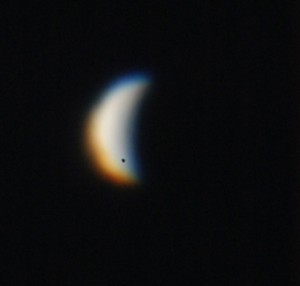 Venus is brightly visible above the Eastern horizon in Cranbrook at 6 a.m. It’s fairly close and in a favourable spot to see. In a telescope it looks like a crescent “moon.” On Jan. 12 it was directly in line between the Sun and the Earth, and was at its closest [they call that (inferior) conjunction] but Venus was not visible then because of the Sun. It is currently speeding ahead of us, in its orbit.
Venus is brightly visible above the Eastern horizon in Cranbrook at 6 a.m. It’s fairly close and in a favourable spot to see. In a telescope it looks like a crescent “moon.” On Jan. 12 it was directly in line between the Sun and the Earth, and was at its closest [they call that (inferior) conjunction] but Venus was not visible then because of the Sun. It is currently speeding ahead of us, in its orbit.
I took this photo of Venus late February at 6 a.m. through the college’s Celestron 11 inch diameter Schmidt-Cassegrain telescope, at 310 power magnification. Nippy at -17°C, but all the equipment worked fine. You can see the crescent, due to the sun sidelighting it from the left, but Venus has a cloud-covered surface and very little detail is visible otherwise.
 The orbital diagram (right) shows the positions of the innermost planets for March 2, 2014. Note that the Sun is in the centre, the purple innermost ring is Mercury, the second ring Venus is blue, third planet Earth is green, and the fourth planet Mars is red. After a gap for the asteroids, Jupiter is the yellow ring further out. The view is from an observer very high above the North Pole of the Earth, looking down.
The orbital diagram (right) shows the positions of the innermost planets for March 2, 2014. Note that the Sun is in the centre, the purple innermost ring is Mercury, the second ring Venus is blue, third planet Earth is green, and the fourth planet Mars is red. After a gap for the asteroids, Jupiter is the yellow ring further out. The view is from an observer very high above the North Pole of the Earth, looking down.
Mars Starts Retrograde Motion and approaches Opposition
Viewed from above the North, the planets move counterclockwise in their orbits, and the innermost planets move faster than outer planets. Thus note that the Earth is catching up to Mars. Mars will be in opposition April 14 and at its closest point to the Earth (in 2014 just 0.62 AU away). This is the best time to view it in a telescope since its surface “canal” markings are then visible as well as its white polar cap. Oppositions occur every 26 months, and this isn’t as close as some others, since its orbit is currently high above the ecliptic (in the starmap, note the bright-red portion of the path is above the ecliptic. The ecliptic is the Earth’s orbit taken as a level reference). Its oppositions can vary from 0.68 to 0.37 AU due to this up/down wandering. Normally Mars slowly drifts Easterly in its position against the background stars, but as we pass, Mars will briefly appear to stop, then move Westerly or “retrograde” from March 1 through May 20.
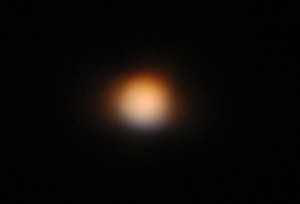 Where is Mars? Mars has been getting remarkably brighter in the past month. Currently Mars rises about 11 p.m., and is a bright red dot visible in Virgo the Virgin, beside the bright star Spica. (To find Spica, there’s an old mneumonic based on the arc of the handle of the big dipper: Arc off to Arcturus, then spin on to Spica. See the top starmap). Virgo is the constellation that trails to the left (the rear) of Leo the Lion. Virgo is hard to identify, but Leo is readily recognizable, with the backwards question mark “?” for its head.
Where is Mars? Mars has been getting remarkably brighter in the past month. Currently Mars rises about 11 p.m., and is a bright red dot visible in Virgo the Virgin, beside the bright star Spica. (To find Spica, there’s an old mneumonic based on the arc of the handle of the big dipper: Arc off to Arcturus, then spin on to Spica. See the top starmap). Virgo is the constellation that trails to the left (the rear) of Leo the Lion. Virgo is hard to identify, but Leo is readily recognizable, with the backwards question mark “?” for its head.

Can we see the two moons of Mars? Phobos and Deimos are only visible in an 18-inch diameter telescope or better, so we can’t see them at the college with our scopes. College of the Rockies Cranbrook has a 10”, 11”, 13” and Ron Evans, Peter Spaans and I have a 14”.
Shown here is a March 2014 Starmap showing the Southern horizon at 9 p.m. Look for bright white Jupiter high up to the south. Don’t confuse it with bright white star Sirius lower to the south. Sirius is called the Dog Star, since it is located in the constellation Canis Major, Orion’s hunting dog. Sirius is the brightest star in the Northern hemisphere.
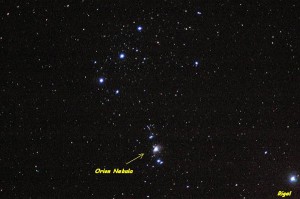 Orion has the Great Nebula, the brightest nebula in the Northern Hemisphere. This photo (right) shows Orion’s Belt above, the three stars in a line, with the fuzzy glowing patch of the Great Nebula (M42) in the middle of his scabbard (or dagger) below.
Orion has the Great Nebula, the brightest nebula in the Northern Hemisphere. This photo (right) shows Orion’s Belt above, the three stars in a line, with the fuzzy glowing patch of the Great Nebula (M42) in the middle of his scabbard (or dagger) below.
This central area of Orion is an ‘asterism,’ also known to the Romans as the ‘Looking Glass,’ a diamond shape with the handle below. The blue-white star at the lower right corner is Rigel, which marks Orion’s knee. This photo was taken at low power, with an 80mm lens, 30 second exposure, with the camera tracking it on a motorized equatorial tripod. The centre is about what you’d see through 7x50mm binoculars.
This glowing green and red gas cloud nebula is big; it’s 24 light years across, and 1,300 light years away.
 If you look through the 15mm eyepiece of the 10” Meade telescope (166x), at first you’d just see the arrowhead group of stars that point to the core Trapezium stars (left), a close group of four stars that emit strong ultraviolet light that cause the gases to glow.
If you look through the 15mm eyepiece of the 10” Meade telescope (166x), at first you’d just see the arrowhead group of stars that point to the core Trapezium stars (left), a close group of four stars that emit strong ultraviolet light that cause the gases to glow.
Most professional photos seen on the Internet don’t show these arrowhead stars, since they overexpose their photos to bring out more of the nebula. Thus this core area becomes saturated white.
But that’s what amateurs look for in our telescope eyepieces to find the Trapezium.
When Galileo looked here, he made sketches that don’t show the nebula. So the nebula is getting brighter as centuries pass and as the curtains of dark gas clouds are slowly blown away like a big bubble from radiation pressure by the newly ignited Suns.
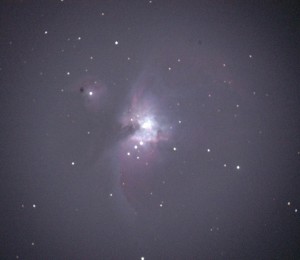 This 30 second exposure (right) taken through the 10” Meade (camera at prime focus set for 1575mm focal length or 31x) shows what you’d see as your eyes dark adapt (at a dark location). You can see the pale nebula structure slowly brighten and extend. Most objects look disappointingly black and white through the eyepiece, but this one glows in colour: Oxygen gas glows green, and the hydrogen gas glows red and purple.
This 30 second exposure (right) taken through the 10” Meade (camera at prime focus set for 1575mm focal length or 31x) shows what you’d see as your eyes dark adapt (at a dark location). You can see the pale nebula structure slowly brighten and extend. Most objects look disappointingly black and white through the eyepiece, but this one glows in colour: Oxygen gas glows green, and the hydrogen gas glows red and purple.
Note the long dark dust cloud arc blocking light along the left side. This separates two nebulas, the larger right side is M42, and the smaller upper left side is M43. If we stack six or more of these photos, we can bring out the fainter extended structure.
Orion currently sets around midnight. Next month we’ll be losing Orion, Taurus and the other winter constellations, since they will be setting in the West when it gets dark.
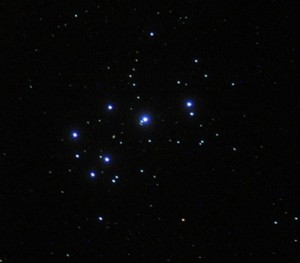 The Pleiades: Looking back at the starmap, the stick figure of Orion is crouched down, holding a shield, raising a club, facing Taurus the Bull (note a V with the red eye of Aldebaran) and to the right above Taurus find the tight cluster of stars M45, the Pleiades, the Seven Sisters stars in a nice little dipper of its own.
The Pleiades: Looking back at the starmap, the stick figure of Orion is crouched down, holding a shield, raising a club, facing Taurus the Bull (note a V with the red eye of Aldebaran) and to the right above Taurus find the tight cluster of stars M45, the Pleiades, the Seven Sisters stars in a nice little dipper of its own.
Used as an eye test once, people with normal eyesight should see six stars.
One of the seven stars has dimmed over the centuries since the Romans named it. This photo was taken with an 180mm lens, 3.6x, a 30 second exposure with the camera riding on an equatorial mount and is like what you’d see with binoculars. If you take longer exposures, you will see a blue haze around the brighter stars, since they are moving through a dust cloud.
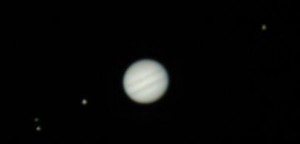 Jupiter is a bright white dot high overhead at 9 p.m., above Orion in the constellation Gemini the Twins. Here is a photo of Jupiter I took through a Meade 10” Schmidt-Cassegrain at 410x, taken earlier when the air was less turbulent. This is the telescope that Allan Reekie donated to the college. A gas giant, the cloud surface shows coloured bands.
Jupiter is a bright white dot high overhead at 9 p.m., above Orion in the constellation Gemini the Twins. Here is a photo of Jupiter I took through a Meade 10” Schmidt-Cassegrain at 410x, taken earlier when the air was less turbulent. This is the telescope that Allan Reekie donated to the college. A gas giant, the cloud surface shows coloured bands.
Where’s the red spot you ask? The planet rotates every 10 hours, so sometimes it’s on the other side of the planet.
With binoculars, you should be able to see the four Galilean moons spread out along a line with the bands. Look again an hour later and the inner moons will have moved noticeably. This photo was shot at 166 power through a 15mm eyepiece, and is what the eye would see.
This photo is two photos combined, one of Jupiter and an overexposed one of Jupiter and its Moons. Since the Moons are so dim, you have to overexpose Jupiter until it’s pure white to show the Moons. Then the banded photo of Jupiter (without the Moons visible) is pasted over the overexposed photo.
The human eye can compensate much better than a camera for these brightness variations. The retina releases chemicals that lower the sensitivity of the rods/cones for bright objects yet keep the rods/cones around it fully sensitive for the dimmer objects (that’s the purple/red spots you get in your vision after looking at a bright light bulb, which fade away after a few seconds as you look elsewhere).
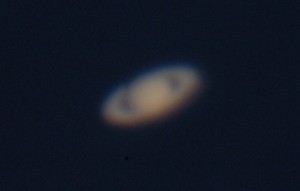 Saturn rises in the East around 2 a.m., and is visible as a bright yellow dot halfway between Mars and Venus, in the constellation Libra.
Saturn rises in the East around 2 a.m., and is visible as a bright yellow dot halfway between Mars and Venus, in the constellation Libra.
Here’s a fuzzy photo I took of Saturn a few weeks ago at 5 a.m. at 311 power magnification. Temperature -17°C, with lots of turbulence, focus was awful, I should have used a lower power. But you can see the continuing downwards tilt of Saturn’s rings.The rings are slowly tipping down which will continue to a maximum in 2017. When they are tipped down, you can see the gaps between the rings more clearly, like the Cassini division and all the others. In 2009, the rings were edge on and invisible. Every 15 years this cycle repeats.
I never had any luck seeing Saturn’s rings with binoculars, even our big 15x70mm Skymasters. You’ll need a small 60mm telescope or better. Sometimes you can see a bright dot nearby Saturn, that’s Titan, the biggest moon of Saturn. That’s bigger than the planet Mercury.
– Rick Nowell is an Astronomy Lab Tech at College of the Rockies, Cranbrook (49°31’03″N, 115°44’37″W, 940m).
All photos by Rick Nowell using a Nikon D100. Starmaps generated by Skyglobe. Orbital diagram generated by TheSky, Student Ed.

